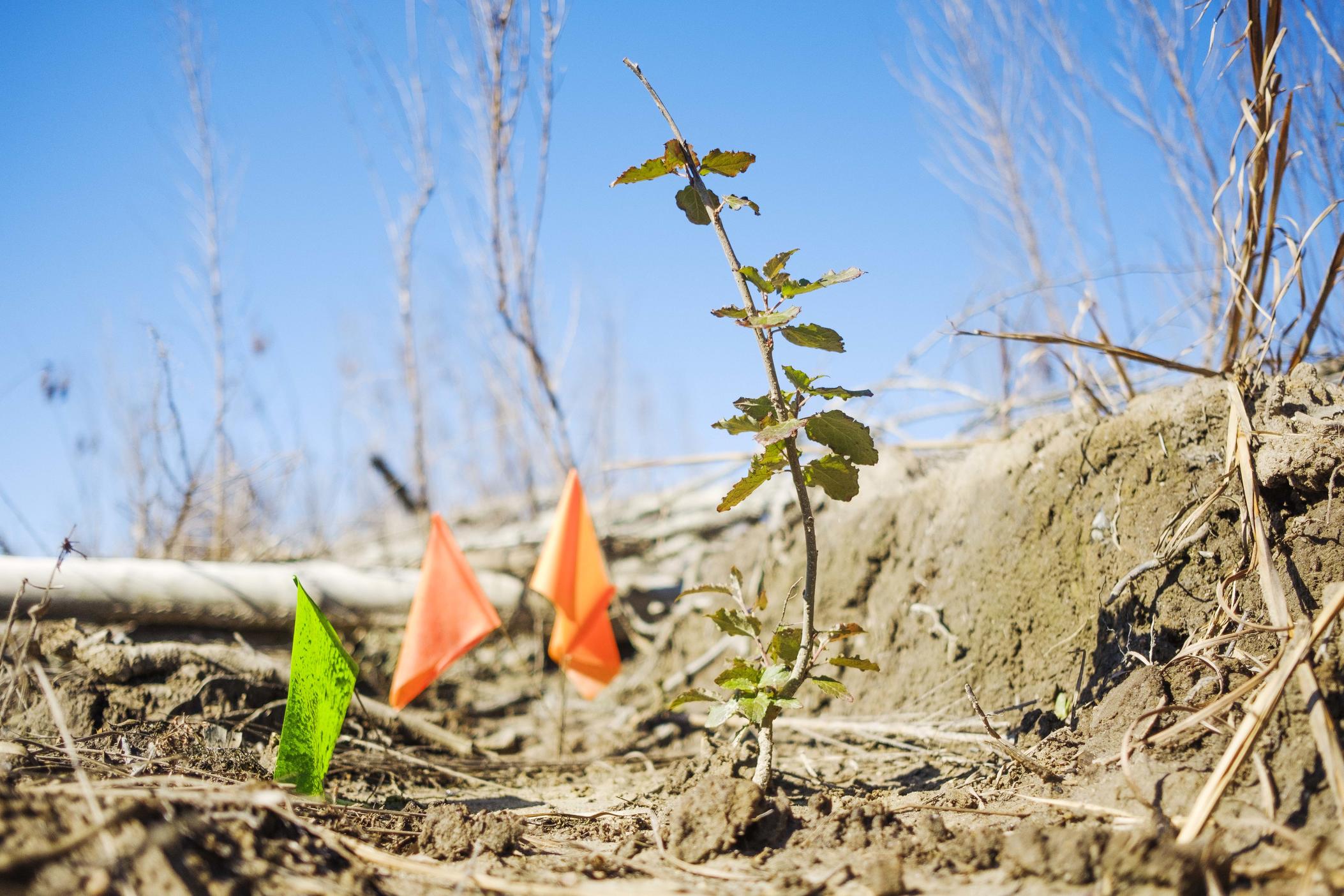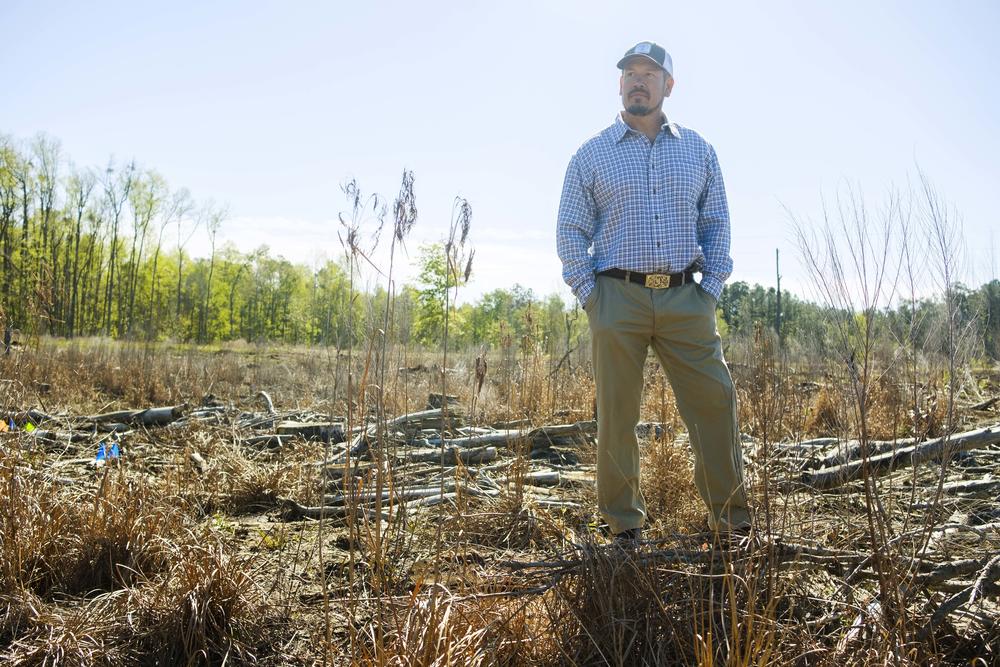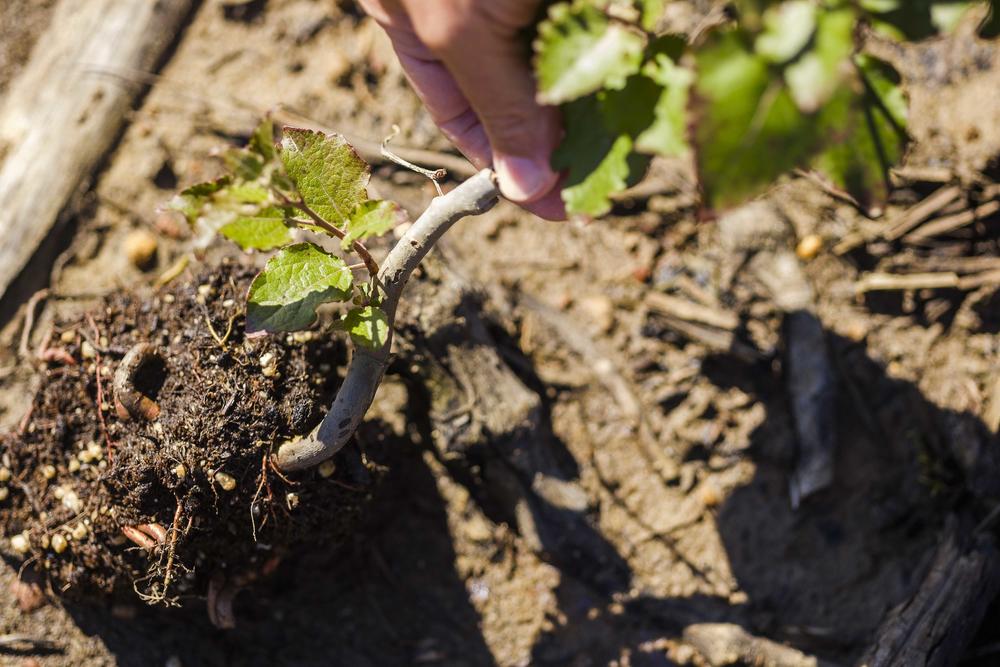Fighting Climate Change With Genetically Modified Trees
6:12 minutes

This article is part of The State of Science, a series featuring science stories from public radio stations across the United States. This story, by Grant Blankenship, was originally published by GPB.
Vince Stanley has a saying, which he holds as true in a commercial forest as on a row crop farm: Every acre has a plan.
In a wetland he owns in Tattnall County, about 70 miles west of Savannah, downhill from an orderly grove of predictably profitable loblolly pines, he is trying out something new.
“Now, look at this guy right here,” Stanley said, pointing out what looked more like a stick in the mud compared to the tupelos growing a few yards away in the deeper water.
This stick, surrounded by pin flags and planted about six feet away from its sister, had signs of new life: dark green leaves.
“That’s impressive,” Stanley said.
And the germ of the new plan for these acres, is something that, until now, Stanley said he didn’t really have.
“We’re just leaving this up to Mother Nature,” he said. “So now with Living Carbon, we’ve gone to Option B.”
This nascent tree and 10,499 others are at the heart of Option B, what might be the first effort of its kind in the nation: genetically engineered trees planted in a forest.
What’s more, these trees are for sale.
Living Carbon is the California-based company which says it has engineered the genome of these saplings that began as a hybrid of two European poplars. When China began allowing commercial planting of genetically engineered trees decades ago, it, too, started with an altered poplar.
Stanley hopes the trees can turn this wetland into a grove of money makers for him and Living Carbon, even during the years before he cuts the trees and sells them.
“They’re going to pay me a sum of money every year and I get to harvest the timber?” he said. “Give me that. Give me that all day long.”
You probably understand “harvest the timber.” A tree grows large, you cut it down and sell it. But Stanley is hoping the genetic engineering will add up to a revenue stream in the years before saw touches wood.
“What we’ve done is slightly tune down a couple of the native genes in our trees and add some neat new ones,” said Living Carbon geneticist Jacob Hoyle.
There are genes from the pumpkin vine. If you’ve seen the New Mexico desert, you’ve seen a creosote bush. A little of it is in there, too, plus genes from a shrub native to the South Pacific island of New Caledonia.
“And they’re working together exclusively to make that photosynthesis process more efficient,” Hoyle said.
None of this is peer reviewed, but what Living Carbon claims is that by helping the trees be better at making their own food from sunlight, Vince Stanley might harvest and sell these hardwoods in his lifetime. That alone would be new.

“We call this a generational cut,” Stanley said. “Whenever you cut bottom lands, it takes 50 years before they can really come back. Now we’re hoping to cut that in half; literally cut it in half.”
That’s because Living Carbon claims it has doubled the growth rate of their trees. What may be even more exciting to Stanley — and the thing really at the heart of Living Carbon’s business model — is what the company promises about how much carbon this new forest can store.
“The way that this land has been treated the last 1,000 years is sequestering this much carbon,” Stanley said.
He meant there is a limit to how much carbon this forest can store, at the baseline rate of carbon capture. Stanley wants to break through that baseline to crack the carbon credit market.
The carbon credit market is where companies (or anyone, really) who puts climate-warming carbon in the atmosphere can pay cash for the carbon someone else has locked up in a tree.
Hypothetically, some part of your carbon pollution gets zeroed out. The other party definitely leaves with cash in pocket.
How much cash that actually equals is up in the air. Stanley knows there have been real doubts about how the market appraises the carbon value of forests in recent years. For example, the Vera Institute, whose carbon appraising methods are the closest thing to a standard in the industry, is scrapping much of its playbook and starting over.
“One of the professionals I went to still said, ‘Hey, look, this is the wild, wild West,’” Stanley said.
But some things are clear to him.
“The carbon credit market does not like you to do the same thing over,” he said.
Whatever the carbon baseline of your forest might be, the market wants it to lock up more. And Stanley said it’s in that “more,” the long-sought-after extra carbon past those millenium-old baselines — that’s where the credits are.
Living Carbon promises a 27% leap above carbon sequester baseline with their new trees. The new credits are what they and Stanley hope to sell.
If this has your head spinning, or if you are surprised this is happening at all, Scott Merkle said you’re not alone.
“For years and years, I’ve been telling people who ask about transgenic trees in the United States, ‘There is no forest tree, transgenic forest tree that’s been given non-regulated status in the United States,” said Merkle, professor of forest biology at the University of Georgia Warnell School of Forestry.
“But here we go with these hybrid poplars, and they’re already out there. And I don’t think hardly anyone knows about this.”
Merkle, like many scientists, thought the transgenic American Chestnut tree, genetically engineered to resist the fungus that almost wiped them out over a century ago, would have been the first in U.S. forests.
So why aren’t they? Merkle said for one thing, the ethics of conservation forestry poses different questions than plantation forestry.
“Do we want to put genetically engineered trees on the landscape and is it safe to do that?” he asked. “And then there’s the whole social aspect of it, about how people just feel about it, their gut reactions to having genetically engineered trees put on the landscape.”
Plus, how can we be sure genetically engineered trees won’t crowd native trees out of the forest?

Merkle said that normally, an arm of the U.S. Department of Agriculture called the Animal and Plant Health Inspection Service, or APHIS, asks these questions.
“You have to submit regular reports to them,” he said. “They come and inspect your plantings. Nothing escapes into the environment. That’s the whole point of it.”
In those experimental settings, trees will sometimes be festooned with bags covering their flowers, a hedge against unintended pollination.
Surely, thought Merkle, APHIS is regulating the Living Carbon poplars.
“But it turns out I thought wrong,” he said.
According to the USDA, when Living Carbon submitted its genetically engineered trees for APHIS review in June 2020, the company’s methods didn’t flag them for regulation.
But In August 2020, just two months later, APHIS guidelines became more stringent.
Had Living Carbon submitted then, it could have been asked to prove its trees were, as Merkle puts it, unlikely to escape. Or in APHIS terms, “unlikely to pose an increased plant pest risk relative to the unmodified plant.”
Living Carbon geneticist Gary Orr said don’t worry, they thought of that.
“And so we’ve kind of circumvented that concern by utilizing trees that are clonally propagated, that are female in nature and that have low fertility,” Orr said.
Orr said since the female clones produce no pollen, there will be no pollination and no seeds.
Scott Merkle has doubts. He said just because a tree is female doesn’t mean it won’t produce seeds.
“It just means that all of those particular trees that grow up from that clone have female flowers on them,” Merkle said.
He said the pollen those flowers need could already be out there.
One of the parent trees of the Living Carbon Tree, the European white poplar, has already escaped its original status as an ornamental tree and is living on its own in parts of Georgia. It’s considered an invasive species in South Carolina and in other states. Merkle said the new trees could seed with these already invasive trees’ help.
“Theoertically. I don’t know if it would really happen or not,” he said.
Merkle said he also wonders if the new trees will grow as well in South Georgia as they did in a controlled experimental setting.
In his hardwood bottom in Tattnall County, Vince Stanley is making space for these concerns in his plan.
“That’s another reason we’re starting our footprint a little bit small right here,” he said. “I’ll just say, like the old-timers: ‘You can handle a snake if you know you’re reaching down to grab a snake.’ We’re looking at this and saying ‘We’re going to have to be able to control this product. Or is there anything to control?’”
And if he learns something that makes him nervous?
“We can go and cut every one of them down if we need to tomorrow.”
Most of the forests in the South are privately owned and many owners are looking to make a profit.
That makes the South the logical market for Living Carbon, which has set up an office in Charleston, S.C., where the company is are actively recruiting foresters and land owners to grow its genetically modified trees.
Grant Blankenship is a reporter at Georgia Public Broadcasting in Atlanta, Georgia.
JOHN DANKOSKY: And now it’s time to check in on The State of Science.
RADIO ANNOUNCER: This is KERA.
RADIO ANNOUNCER: For WWNO–
RADIO ANNOUNCER: St. Louis Public Radio.
RADIO ANNOUNCER: Iowa Public Radio News.
JOHN DANKOSKY: Local science stories of national significance.
An experiment is happening in a South Georgia forest. A startup claims that hybrid poplar trees will be able to sequester tons of carbon from the atmosphere. What’s more, this is the first time a genetically modified tree has been planted in a US forest. But what exactly do we know about these trees? And will this carbon capture project actually work?
Joining me to talk through this story is my guest Grant Blankenship. He’s a reporter for Georgia Public Broadcasting, based in Macon, Georgia. Grant, welcome to Science Friday.
GRANT BLANKENSHIP: Yeah. Thank you so much for having me.
JOHN DANKOSKY: So first of all, tell us, what exactly are these trees genetically speaking, and how exactly were they made?
GRANT BLANKENSHIP: Well, so what you’re starting with is actually a pretty common tree. It’s a hybrid of two poplars that are native to Europe, the white poplar and the quaking aspen. So here the researchers cloned one of these female poplar hybrids a bunch of times. And then they took what’s a common soil bacteria and used it to carry genes from plants like pumpkin and creosote into the genome of these tiny poplar clones.
And so the idea here is that by restricting the expression of that one gene, the trees would become better at making their own food, and in turn they would really pack on the biomass.
JOHN DANKOSKY: So what exactly is the carbon sequestration that’s being promised with these trees? Because we hear an awful lot about attempts to sequester more carbon from the atmosphere.
GRANT BLANKENSHIP: Right. So Living Carbon is the name of the company that’s selling these trees. And they make two claims about them. One, they promise that this genetic manipulation of photosynthesis is going to make the trees grow twice as fast as unmodified poplars, as the ones that haven’t had this transgenic overhaul.
And then, remember photosynthesis– trees breathe in carbon dioxide on the front end of photosynthesis. So the company’s second claim is that, as these trees are growing twice as fast, they’re also adding almost 30% more carbon-based biomass than in these unmodified trees.
JOHN DANKOSKY: Wow. So these are some pretty big claims. This is not peer reviewed stuff. Are these estimates just coming from the company? I mean, how accurate are these?
GRANT BLANKENSHIP: Right. I mean, so far, these estimates are just coming from the company. This isn’t something that’s been peer reviewed in a journal. And it’s also from a laboratory experiment, very controlled conditions, where they’ve observed these effects, this product. Yeah. I mean, so far, there really isn’t any proof from an actual forest planting that these trees are going to do what the company says they will.
JOHN DANKOSKY: This is Science Friday, from WNYC Studios.
So Grant, this is important to note. This isn’t just a carbon sequestration effort. This is being done because people want to harvest these trees for the lumber markets. So what do we know about that?
GRANT BLANKENSHIP: Right. Yeah. I mean, this is really, really being driven by market incentives, the free market economy and all that. So the first thing to understand is that they’re aimed at two very different parts of the market, these trees. The first is just what you’d think. It’s wood.
My assumption is that a mill is probably pretty agnostic about the genome of your tree. You know, wood is wood. But you should know that when you’re in one of those big boxes hardware stores and you’re in the lumber aisle, the odds are really good that what you’re looking at, the plywood there, is poplar wood.
The second marketing question here is the carbon credit market. So very broadly, that’s where, if you’re a carbon polluter, you can buy someone else’s sequestered carbon and sort of offset your misdeeds. The hope here is that these new trees are going to amp up a forester’s ability to sell carbon credits on that carbon credit market.
That’s really the hope of Vince Stanley, the landowner, who’s participating in this experiment. He would absolutely love to make extra money on carbon socked away in tree trunks, right, long before he ever cuts them down.
VINCE STANLEY: You’re going to pay me a sum of money every year and I get to harvest the timber? Give me that. Give me that all day long.
GRANT BLANKENSHIP: Yeah. And so the deal is, here in the South, it’s like 90% of our forest land is privately owned. Living Carbon has set up shop in South Carolina, and they’re really betting that there are lots and lots more foresters in the South who want the same thing that Vince Stanley does.
JOHN DANKOSKY: Are there concerns, Grant, about sending out these genetically modified trees into the world, planting them in forests, and then maybe having them spread beyond our control?
GRANT BLANKENSHIP: Well, yeah. I mean, here’s the crazy thing. These trees are so new, it’s hard to know if people even know enough about them to be concerned yet. Scott Merkle is a forest biologist with the University of Georgia’s Warnell School of Forestry.
SCOTT MERKLE: For years and years, I’ve been telling people who ask about transgenic trees in the United States, there is no transgenic forest tree that’s been given non-regulated status in the United States. But here we go with these hybrid poplars. And they’re already out there. And I don’t think hardly anyone knows about this.
GRANT BLANKENSHIP: And these trees aren’t regulated because Living Carbon submitted their trees to the USDA just two months before current rules on reviewing genetically modified plants took effect. They were sort of grandfathered into the older rules. And the original tree, that hybrid poplar, it’s already an invasive species in a number of US states, even in parts of Georgia.
And so Scott Merkle, the forest biologist, he says, even if the new trees are all-female clones, the pollen they need to seed could come from these garden-variety poplars that are already invasive on the landscape. He says, of course, he can’t be sure that that’s going to happen, but it’s really something worth considering.
JOHN DANKOSKY: It’s such an interesting story, a fascinating technology, and, as we used to say on the program, may be a good thing/bad thing about the environment, Grant. I’m glad that you’re covering it. Thanks so much for joining us.
GRANT BLANKENSHIP: Yeah, my pleasure. Thank you for having me.
JOHN DANKOSKY: Grant Blankenship is a reporter for Georgia Public Broadcasting, based in Macon, Georgia.
Copyright © 2023 Science Friday Initiative. All rights reserved. Science Friday transcripts are produced on a tight deadline by 3Play Media. Fidelity to the original aired/published audio or video file might vary, and text might be updated or amended in the future. For the authoritative record of Science Friday’s programming, please visit the original aired/published recording. For terms of use and more information, visit our policies pages at http://www.sciencefriday.com/about/policies/.
John Dankosky works with the radio team to create our weekly show, and is helping to build our State of Science Reporting Network. He’s also been a long-time guest host on Science Friday. He and his wife have three cats, thousands of bees, and a yoga studio in the sleepy Northwest hills of Connecticut.
Kathleen Davis is a producer and fill-in host at Science Friday, which means she spends her weeks researching, writing, editing, and sometimes talking into a microphone. She’s always eager to talk about freshwater lakes and Coney Island diners.